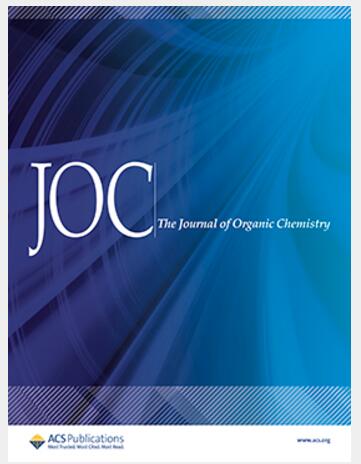Mechanistic Insights into the Propagation Cycle of the Hofmann–Löffler–Freytag Reaction: Halogen vs Hydrogen Atom Transfer
IF 3.6
2区 化学
Q1 CHEMISTRY, ORGANIC
引用次数: 0
Abstract
The Hofmann–Löffler–Freytag (HLF) reaction is a method that employs N-chlorinated precursors in radical-mediated rearrangement cycles to synthesize pyrrolidine rings and C–H functionalized products. This study aims to elucidate the mechanism of the propagation cycle, identify the rate-limiting step, and uncover the factors influencing the regioselectivity of the HLF reaction. Combining experimental techniques─laser flash photolysis (LFP), electron paramagnetic resonance (EPR), and nuclear magnetic resonance (NMR)─with computational density functional theory (DFT) calculations and kinetic modeling, we challenge the previous assumption that the hydrogen atom transfer (HAT) step was rate-limiting and regioselectivity was under both thermodynamic and kinetic control. We have identified that the halogen atom transfer (XAT) step in the propagation cycle of the HLF reaction follows pseudo-first-order kinetics and has the largest transition-state barrier. Additionally, we observed that regioselectivity is exclusively controlled by the intramolecular hydrogen atom transfer kinetics, while no thermodynamic preference exists in the formation of C6- and C5-chlorinated products. Our work predicts how to accelerate the HLF reaction and how we can control the regioselectivity by the smarter selection of substrates based on calculations, which could provide better control of the reaction when implemented in organic synthesis.

对Hofmann-Löffler-Freytag反应传播周期的机械见解:卤素与氢原子转移
Hofmann-Löffler-Freytag (HLF)反应是一种在自由基介导的重排循环中利用n -氯化前体合成吡啶环和C-H功能化产物的方法。本研究旨在阐明其增殖周期的机理,确定其限速步骤,揭示影响HLF反应区域选择性的因素。结合实验技术──激光闪光光解(LFP)、电子顺磁共振(EPR)和核磁共振(NMR)──与计算密度泛函理论(DFT)计算和动力学建模,我们挑战了先前的假设,即氢原子转移(HAT)步骤是限速的,区域选择性是由热力学和动力学控制的。我们发现,在HLF反应的传播周期中,卤素原子转移(XAT)步骤遵循准一级动力学,并且具有最大的过渡态势垒。此外,我们观察到区域选择性完全由分子内氢原子转移动力学控制,而C6-和c5氯化产物的形成不存在热力学偏好。我们的工作预测了如何加速HLF反应,以及如何通过计算更智能地选择底物来控制区域选择性,这可以在有机合成中更好地控制反应。
本文章由计算机程序翻译,如有差异,请以英文原文为准。
求助全文
约1分钟内获得全文
求助全文
来源期刊

Journal of Organic Chemistry
化学-有机化学
CiteScore
6.20
自引率
11.10%
发文量
1467
审稿时长
2 months
期刊介绍:
Journal of Organic Chemistry welcomes original contributions of fundamental research in all branches of the theory and practice of organic chemistry. In selecting manuscripts for publication, the editors place emphasis on the quality and novelty of the work, as well as the breadth of interest to the organic chemistry community.
 求助内容:
求助内容: 应助结果提醒方式:
应助结果提醒方式:


